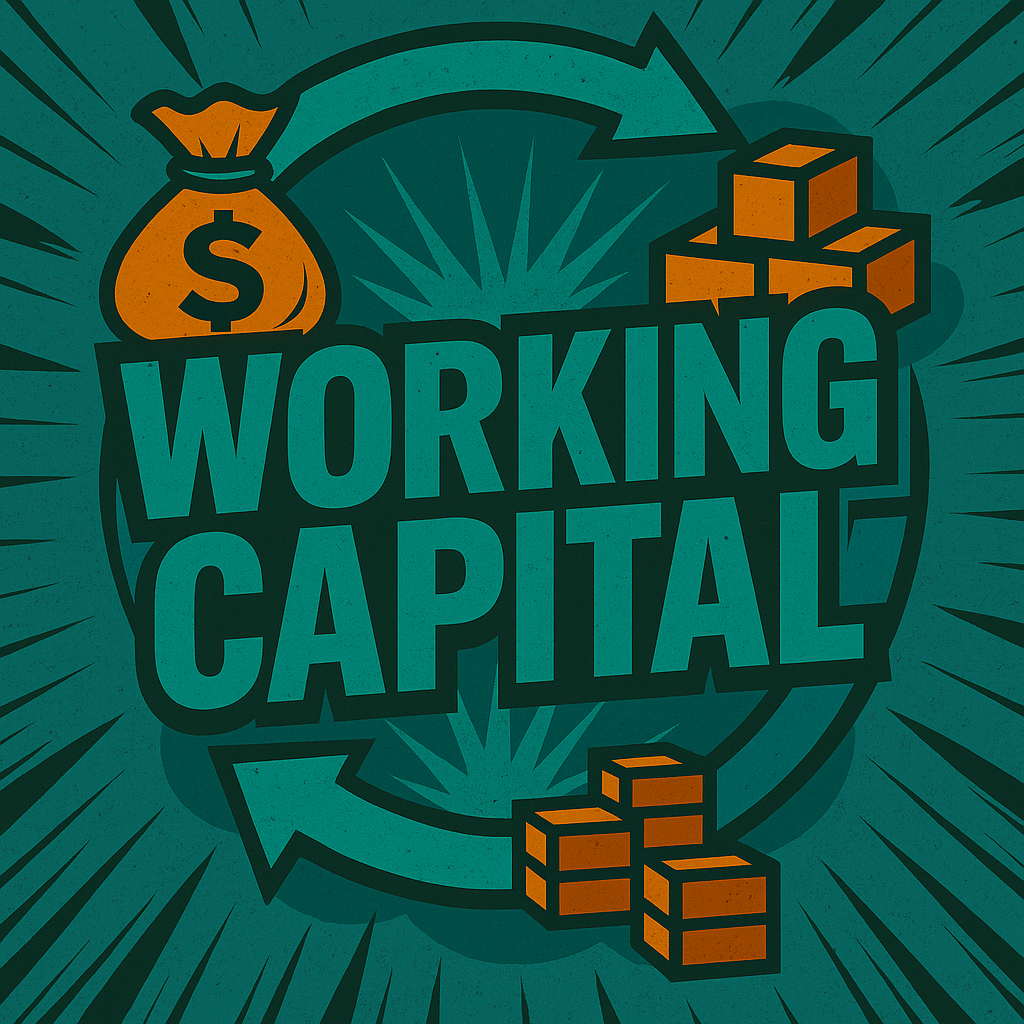
Working Capital
“Fuel for the daily grind”
Working Capital represents the cash and other short-term assets your business uses to operate day-to-day.
It’s calculated as: Working Capital = Current Assets – Current Liabilities
Practical Example
A manufacturer has:
Current Assets: $400,000
Current Liabilities: $300,000
Working Capital = $100,000
It answers a simple but vital question:
Does the business have enough short-term resources to cover its short-term obligations?
Positive working capital means a business can meet its bills, payroll, and operating needs without stress.
Negative working capital means money is tied up — in receivables, inventory, or slow cash flow — and signals risk ahead.
⚙️ Key Components
Current Assets
Includes cash, accounts receivable, and inventory — resources that can be converted into cash within a year.
Current Liabilities
Includes accounts payable, short-term loans, accrued expenses — obligations due within a year.
Working Capital Formula
Working Capital = Current Assets – Current Liabilities
Positive working capital means short-term assets (like cash, receivables, and inventory) exceed short-term liabilities (like payables and debt due soon). This gives a business breathing room — enough cushion to pay bills, fund operations, and take advantage of opportunities without scrambling for financing. It’s a sign of financial flexibility and stability.
Negative working capital, on the other hand, means short-term liabilities exceed short-term assets. That usually signals tight cash flow — a business may need to delay payments, dip into credit lines, or rely on external funding just to stay current. While some fast-moving industries (like grocery or certain retail) can operate with negative working capital, for most businesses it’s a warning flag that cash flow management needs immediate attention.
✅ In short:
Positive working capital = strength and stability.
Negative working capital = strain and risk.
✦ Why it's so darn important
Operational Lifeline: Working capital keeps your business running smoothly between paying suppliers and collecting from customers.
Liquidity Insight: It reflects short-term health and resilience — your ability to react quickly to opportunities or challenges.
Efficiency Indicator: It shows how well you manage the cash conversion cycle — how quickly your business turns investments (inventory, receivables) back into usable cash.
Strategic Signal: Changes in working capital often reveal growth pressures, tightening cash flow, or overly aggressive payment terms.
Example: Positive Working Capital — Smooth Operations
Scenario:
A wholesale distributor keeps tight control of inventory and gets paid promptly by customers.
Balance Sheet Snapshot:
Current Assets: $500,000 (cash $100k, receivables $250k, inventory $150k)
Current Liabilities: $300,000 (accounts payable $200k, short-term debt $100k)
Working Capital = $500,000 – $300,000 = $200,000 (positive)
Interpretation:
The company has enough short-term assets to cover its obligations almost 1.7 times over.
Even if a few invoices are paid late, there’s still a cash cushion for payroll, rent, and inventory restocking.
The owner can confidently fund growth internally — maybe by buying more stock or extending terms to loyal customers — without needing extra financing.
Result: The business runs smoothly, with flexibility to invest, react, and grow.
Example: Negative Working Capital — Cash Crunch
Scenario:
A growing manufacturer has booming sales but slow collections and rising supplier costs.
Balance Sheet Snapshot:
Current Assets: $400,000 (cash $20k, receivables $250k, inventory $130k)
Current Liabilities: $500,000 (accounts payable $300k, short-term loans $200k)
Working Capital = $400,000 – $500,000 = –$100,000 (negative)
Interpretation:
The business owes $100k more than it currently has on hand.
It’s likely relying on credit lines or delaying payments to vendors to stay afloat.
If customer payments are delayed or a major expense hits, the company could face a cash flow crisis even though sales look strong.
Result: Profits may look fine, but operations are under pressure — growth without liquidity is creating financial strain.
⚠️ Common Pitfalls
Expanding sales faster than cash flow can support.
Paying vendors faster than customers pay you.
Holding too much inventory or offering overly generous payment terms.
Treating working capital as an accounting metric instead of a management tool.
🪙 Best Practices
Monitor working capital monthly, not quarterly.
Encourage faster customer payments (early pay incentives).
Negotiate better terms with suppliers.
Maintain lean inventory without stockouts.
Align working capital management with cash flow forecasting.

Takeaway
Positive working capital means freedom and flexibility.
Negative working capital means risk and restriction.
Managing this balance determines whether a business grows sustainably — or runs out of gas mid-journey.

